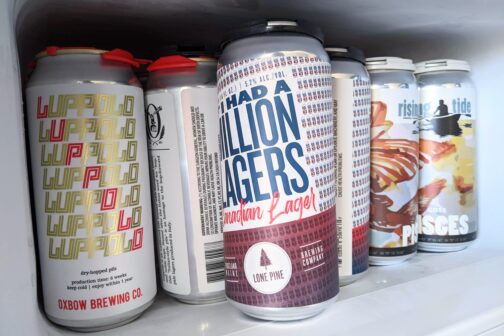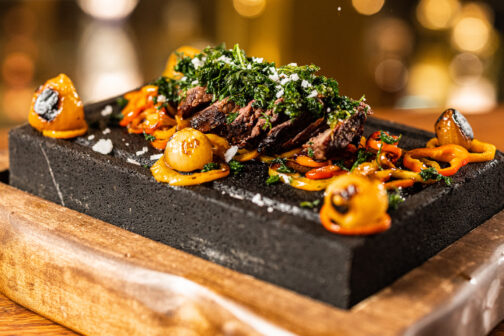I just got back from a vacation in Maine, where I consumed about 20 pints of Maine-brewed beer in six days. But this article is not about my vacation or unhealthy habits. It’s about Maine’s commitment to truly local beer.
Pint after pint, we saw and tasted brews with local roots deeper than the address where they were made. We drank beers made with seaweed or kelp and a Rising Tide salty gose brewed with seawater. Oxbow regularly creates beers with 100 percent Maine-grown ingredients. Maine hops, Maine malts, Maine yeast, Maine oats: everything local, always. In wintertime, they even brew a stout with Damariscotta River oysters.
One morning, in the clarity of sobriety, I got to wondering: what would a truly native Texan beer style look like? What would our beer taste like if Texas breweries had such a strong commitment to the state’s produce? Is such a fealty to Texas ingredients even possible?
The answer is complicated. Almost every ingredient in beer can be grown in Texas. TexMalt, in Fort Worth, is a renowned supplier of malts, and Community Cultures Yeast Lab in San Antonio is a partner to many producers. Breweries across the state use locally-grown additives, like mesquite beans, herbs, jalapeño peppers, and oats.
But this thinking isn’t too common yet, and there is one big problem: hops.

Hops are flowers grown on climbing plants, and they require lots of watering. One study claims that the hops in a pint of beer are the product of 50 pints of water. The plant also needs a certain amount of sunshine, no more or less, although different varieties can tolerate different temperatures (European hops prefer cooler air than American types).
Even that problem may yet be solved. Jester King, Texas’ leader in native-ingredient beers, made an “All-Texas” beer in 2021 with hops grown in a friend’s backyard. (I’m not sure, but this might be the state’s first-ever completely native brew.) Two businesses opened in previous years promising hydroponically grown hops, Dallas Hop Works and Austin’s The Hopperdashery. Unfortunately, both now appear to be inactive. Circle Brewing in Austin will soon open a “brewing farm” in Elgin; before the pandemic, it said that its plans included growing hops onsite.
Michael Peticolas, owner of Peticolas Brewing Company, has thought seriously about making an all-local brew. He says that the biggest challenge to an all-Texan beer in regular production is scale. Even if you can grow hops, or source TexMalt barley (which he admires), it’s hard to achieve the quantities and consistency needed to put the resulting beer on regular rotation.
“We’ve grown hops ourselves,” Peticolas says. “We’ve used some of our hops in our cask beers. We thought about combining all of those [local] elements and putting them into a beer. But we’re not looking to do a beer once, we’re looking to do a beer that becomes successful, and you can’t buy ingredients in those quantities.”
Right now, additives are the primary way Texas breweries connect with their native environment. Jester King’s collaboration beer with barbecuer Aaron Franklin includes smoked figs; just across the road, Beerburg throws mesquite beans into brown ale and uses herbs found on its own property, like bee balm and mugwort. San Marcos’ Roughhouse Brewing estimates 85 percent of its grains and malts are in-state and makes a springtime brew with flowers from its garden.
Texas’ Hispanic heritage is another obvious path to local flavor. Tupps frequently serves a poblano pale ale, and I need to stop by On Rotation soon to try its jalapeño saison. Probably my all-time favorite beer from Four Corners is its grapefruit saison Queen Bee, which most recently starred citrus from Bayview, Texas.
“There’s a brewery in San Antonio called Islla Street that does a beer with Chamoy,” says Ruvani de Silva, an Austin-based beer writer who recently documented “farm-to-glass” breweries for Texas Monthly. “Freetail in San Antonio has used Chamoy. With the opening of Desert Door Distillery outside Austin, making Texas sotol, some breweries aged their beer in sotol barrels. That was something that I thought was really interesting and a way to get a really cool, very local ingredient into beer. It sort of phased out with COVID, I haven’t seen one for a long time, but I would love to see that again.”
De Silva points out that there’s one Texas ingredient, central to everything, that I’d been forgetting: the water.
The Hill Country’s limestone-filtered aquifer produces water that would make brewers in other lands jealous. She told me about a trip to a certain other state which shall not be named, where every single beer seemed disappointing—until she found out that the region’s water supply had a whole lot of contaminants. The one good brewery she found there was conducting its own filtration.
“Water is a big, big thing,” she says, as the moral to the story. “Most of those [Hill Country] breweries have onsite wells. Having that onsite water is definitely a big thing in making a beer particularly local.”
Peticolas isn’t shy about bragging on Dallas water, either. “The mineral content in our water here in North Texas is favorable for brewing. Personally I think the beers you get here in North Texas are on par with what you get with Oregon and Colorado because of that backbone of that water.”
Ultimately, while the all-local idea isn’t currently right for Peticolas Brewing’s focus on repeatable beers with consistent sourcing, its owner hopes somebody else will give the concept a try.
“There’s definitely the room to do [an all-local beer],” Peticolas says. “I guess it’s the hops, and consistency, and making it awesome.”
Get the SideDish Newsletter
Author






